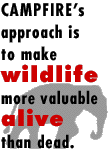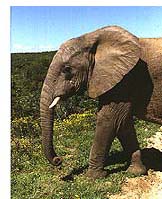
African elephant images ©Greg Smith, Courteney Boot Co.


Who benefits from African wildlife? Typically, it's the airlines and safari agencies rather than local people who
 instead have to deal with threats from lions and competition from elephants. Who makes the decisions about wildlife management? Typically, it's the national government, with some input from poachers and the black market.
instead have to deal with threats from lions and competition from elephants. Who makes the decisions about wildlife management? Typically, it's the national government, with some input from poachers and the black market.
In Zimbabwe, however, a nation-wide program called CAMPFIRE (Communal Areas Management Programme for Indigenous Resources) has turned that equation upside down in search of a more equitable and workable arrangement.
Essentially, CAMPFIRE gives the ownership, control and benefits of wildlife to the local community. Since it began in 1989, the organization's goal has been to "allow wild species to contribute to livelihood, and allow local people to make management decisions," says Jon Hutton, a project manager for Africa Resources Trust and an advisor to the organization.
Managing wildlife often means killing it, and under the CAMPFIRE system, when animals become too abundant, local councils can authorize annual culling operations. "Culling is a brutal activity, and it seems inhumane," wrote New York Times journalist Raymond Bonner in 1993 (see "At the Hand of Man" in the bibliography). "But is it not also brutal and inhumane to allow human beings to suffer from malnutrition amidst plenty?" Culling of antelopes doubles or triples the amount of protein for some villagers in Zimbabwe, who live amidst abundant wildlife, Bonner said, and gives them an interest in preserving the herds.
Trophy hunting is another way to profit from wildlife, Hutton says. "Americans pay very well to kill an elephant or a lion. In return, the communities are happy to see elephants, and are setting aside large areas of land for them. So the mortality of wildlife is producing conservation gains."
(The "use-it-or-lose-it" philosophy is also at work in Costa Rica, where national conservation areas promote non-destructive, profitable uses for nature, including tourism, earning royalties from naturally derived drugs and chemicals, storing carbon dioxide, and protecting watersheds. The Why Files covered ecological restoration in one Costa Rican conservation area .)
The ivory ban has weighed heavily on local communities, which could not sell ivory even if it came from "problem" elephants that were shot after threatening crops or people. Bonner estimated that selling just this ivory would have raised community income by 25 percent.
And even though wildlife attracts tourists to game lodges and viewing stations, this tourism is much more lucrative to airlines and rich people than to poor Africans.  As Richard Leakey told Bonner while Leakey was director of Kenya's Wildlife Department, "With very few exceptions, people living in areas with wildlife receive few or none of the economic benefits of tourism." Indeed, a 1988 study concluded that less than 10 percent of gross revenues from tourism remained in the Maasai Mara region, site to a premier Kenyan game park. (As Bonner says, game parks interest foreigners more than Africans. "Seeing an African on a game drive in one of Kenya's parks is more rare than spotting a rhino or a leopard.")
As Richard Leakey told Bonner while Leakey was director of Kenya's Wildlife Department, "With very few exceptions, people living in areas with wildlife receive few or none of the economic benefits of tourism." Indeed, a 1988 study concluded that less than 10 percent of gross revenues from tourism remained in the Maasai Mara region, site to a premier Kenyan game park. (As Bonner says, game parks interest foreigners more than Africans. "Seeing an African on a game drive in one of Kenya's parks is more rare than spotting a rhino or a leopard.")
Under CAMPFIRE's program, however, local communities are authorized to negotiate with tourism operators for a reasonable share of income. It's another factor designed to make wildlife more valuable alive than dead.
CAMPFIRE's approach is controversial, and animal-welfare folks tend to see it as an excuse for killing. But conservation biologists, aware that protection is not working in the developing world, are taking a wait-and-see attitude. Giving ownership and control of wildlife to local people is "a double-edged sword," says Stanley Temple, a University of Wisconsin-Madison expert in biodiversity preservation. "There are advantages and disadvantages to any system of ownership of wildlife. While the western, public ownership model seems to work well in developed countries, it's not always applicable to developing countries," he notes.
Concerning CAMPFIRE's novel approach, Temple says, "Regardless of the type of ownership pattern, history tells us that without considerable incentives or coercion, people tend to overexploit wild populations." Since there are "very strong incentives to go for short-term profits and ignore the long-term future management of the population," Temple says the important question is whether "there are enough incentives for local people to manage them in a sustainable way."
For a favorable assessment of CAMPFIRE. And a not-so-favorable one.
In countries with heavy population density (Africa has the fastest rate of population growth among the continents) "neither system has worked well," Temple points out. "If there's a demand and you have poor people with a high population density, history tells us what happens -- the wildlife suffers."
Still, Temple argues that "adaptive management" -- learning from experience -- is a much better approach to managing wildlife than starting from dogma (indeed, CITES has agreed to revisit the ivory ban if poaching increases). "You try something, monitor it, and see how it works," he says, "with the prior acceptance that the policy is not cast in stone, and you may have to change fairly abruptly if signs of problems come up."
Ready for some elephant oddities?





